项目准备
1、添加相关依赖
<dependencies>
<dependency>
<groupId>mysql</groupId>
<artifactId>mysql-connector-java</artifactId>
<version>8.0.19</version>
</dependency>
<dependency>
<groupId>org.mybatis</groupId>
<artifactId>mybatis</artifactId>
<version>3.5.3</version>
</dependency>
<dependency>
<groupId>junit</groupId>
<artifactId>junit</artifactId>
<version>4.12</version>
</dependency>
</dependencies>
2、resources根目录下创建全局配置文件 SqlMapConfiguration.xml
<?xml version="1.0" encoding="UTF-8" ?>
<!DOCTYPE configuration
PUBLIC "-//mybatis.org//DTD Config 3.0//EN"
"http://mybatis.org/dtd/mybatis-3-config.dtd">
<configuration>
<!--环境配置-->
<environments default="mysql">
<!--配置数据库的环境-->
<environment id="mysql">
<!--配置事务类型-->
<transactionManager type="JDBC"></transactionManager>
<!--配置数据源(连接池)-->
<dataSource type="POOLED">
<!--配置连接数据库的四个基本信息-->
<property name="driver" value="com.mysql.jdbc.Driver"/>
<!--url中的mybatis就是数据库名称,serverTimezone是时区,没有配置时可能会抛出异常-->
<property name="url" value="jdbc:mysql://localhost:3306/mybatis?serverTimezone=UTC"/>
<property name="username" value="root"/>
<property name="password" value="12345"/>
</dataSource>
</environment>
</environments>
<mappers>
<mapper resource="com/example/dao/UserMapper.xml"/>
</mappers>
</configuration>
3、创建映射文件 UserMapper.xml
<?xml version="1.0" encoding="UTF-8" ?>
<!DOCTYPE mapper
PUBLIC "-//mybatis.org//DTD Mapper 3.0//EN"
"http://mybatis.org/dtd/mybatis-3-mapper.dtd">
<!--namespace填写的是Mapper接口的全限定名-->
<mapper namespace="com.example.dao.UserMapper">
<!--
id必须与接口的方法名一致
select语句会返回查询结果,所以需要配置一个resultType将查询结果赋值给对象的属性
-->
<select id="findAll" resultType="com.example.pojo.User">
select * FROM user
</select>
</mapper>
4、创建UserMapper接口(接口文件和映射文件的包结构保证相同)
public interface UserMapper {
List<User> findAll();
}
5、创建POJO类接收返回的数据 User
package com.example.pojo;
import java.util.Date;
public class User {
private Integer id;
private String username;
private Date birthday;
private String gender;
private String address;
//省略了getter、setter和toString方法
}
6、编写测试类是否可以运行
public class UserMapperTest {
@Test
public void testFindAll() throws IOException {
// 1、读取配置文件(从类路径下开始读取)
InputStream in = Resources.getResourceAsStream("SqlMapConfiguration.xml");
// 2、创建SqlSessionFactory工厂
SqlSessionFactoryBuilder builder = new SqlSessionFactoryBuilder();
SqlSessionFactory sqlSessionFactory = builder.build(in);
// 3、使用工厂生产SqlSession对象
SqlSession sqlSession = sqlSessionFactory.openSession();
// 4、使用SQLSession创建Dao接口的代理对象
UserMapper userMapper = sqlSession.getMapper(UserMapper.class);
// 5、使用代理对象执行方法
List<User> users = userMapper.findAll();
for (User user: users
) {
System.out.println(user);
}
// 6、释放资源
sqlSession.close();
in.close();
}
}
编写MyBatis实现的查询方法的代码
1、去除mybatis的jar包
<!--<dependency>-->
<!--<groupId>org.mybatis</groupId>-->
<!--<artifactId>mybatis</artifactId>-->
<!--<version>3.5.3</version>-->
<!--</dependency>-->
去除相关依赖后,测试代码报红,如下:
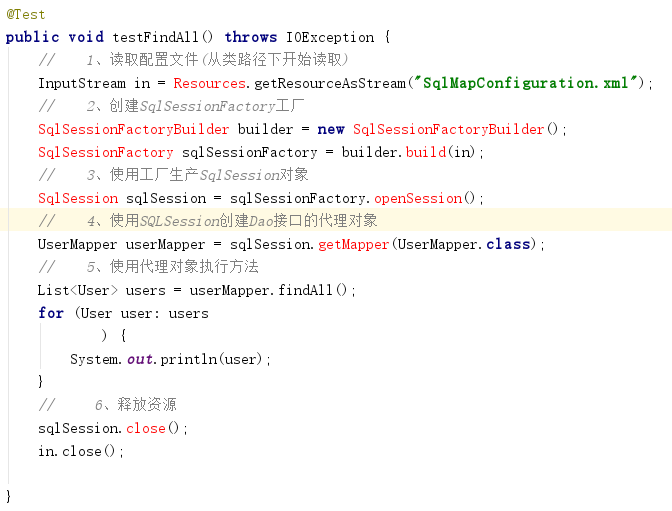
这说明缺乏MyBatis提供的类对象

还有,因为没有提供MyBatis的jar支持,所以全局配置文件和映射文件上的MyBatis约束不能用了,直接删掉即可
public class Resources
public class SqlSessionFactoryBuilder
public interface SqlSessionFactory
public interface SqlSession
2、创建Resources类
/**
* 使用类加载器读取配置文件的类
*/
public class Resources {
/**
* 根据传入的参数,获取一个字节输入流
* 通过当前类的字节码获取类加载器,并根据类加载器读取配置文件从而获得一个流
* @param globalXmlFileName
* @return
*/
public static InputStream getResourceAsStream(String globalXmlFileName){
return Resources.class.getClassLoader().getResourceAsStream(globalXmlFileName);
}
}
导入自己创建的Resources类,效果如下:
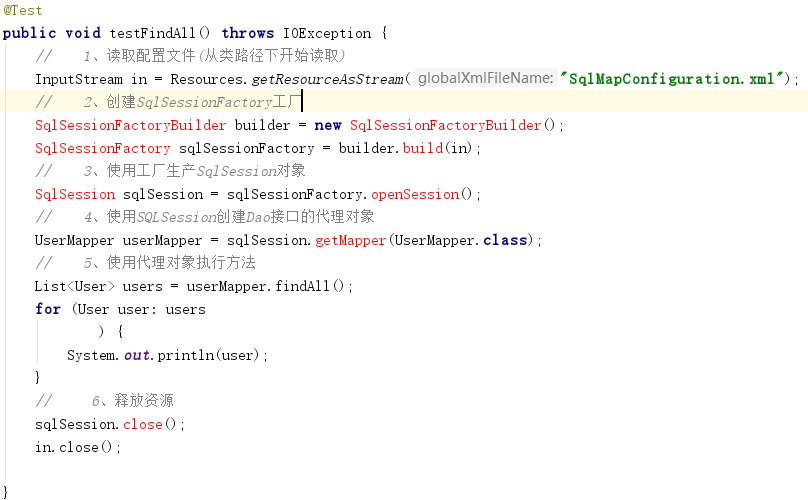
3、创建SqlSessionFactoryBuilder类,
通过该对象的build方法传入全局配置文件的输入流,创建SqlSessionFactory对象
/**
* 用于常见一个sqlSessionFactory对象
*/
public class SqlSessionFactoryBuilder {
/**
* 根据参数的字节输入流来构建一个SQLSessionFactory工厂
* @param inputStream
* @return
*/
public SqlSessionFactory build(InputStream inputStream){
return null;
};
}
此时没有SqlSessionFactory类,开发工具提示无法解析
导包
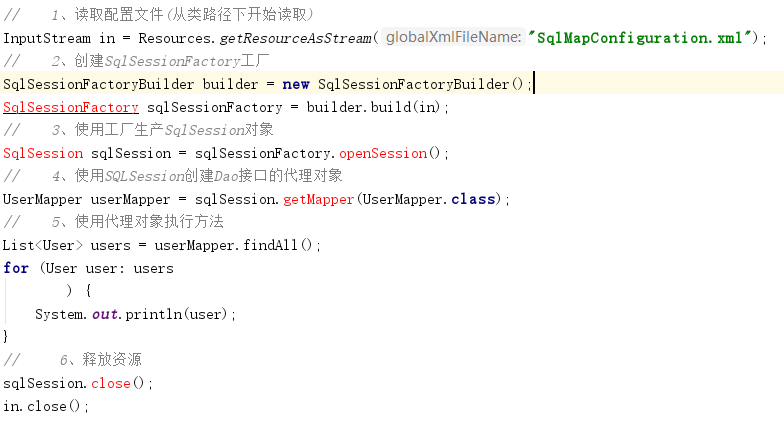
4、创建SqlSessionFactory接口
public interface SqlSessionFactory {
/**
* 用于打开一个新的sqlSession对象
*/
SqlSession openSession();
}
此时没有 SqlSession,开发工具提示无法解析
导包

5、创建 SqlSession接口
SqlSession需要提供getMapper方法来创建代理对象
提供close方法接收与数据库的会话
/**
* 自定义MyBatis中和数据库交互的核心类
* 它里面可以创建dao接口的代理对象
*/
public interface SqlSession {
/**
* 根据参数创建一个代理对象
* @param daoInterfaceClass dao的接口字节码
* @param <T>
* @return
*/
<T> T getMapper(Class<T> daoInterfaceClass);
/**
* 释放资源
*/
void close();
}
导包

全部所需的类都准备完成,还需要实现每个类的功能和职责
3、实现类的功能
1、创建解析xml读取配置信息的类,
public class XMLConfigBuilder {
/**
* 解析主配置文件,把里面的内容填充到DefaultSqlSession所需要的地方
* 使用的技术:
* dom4j+xpath
*/
public static Configuration loadConfiguration(InputStream config){
try{
//定义封装连接信息的配置对象(mybatis的配置对象)
Configuration cfg = new Configuration();
//1.获取SAXReader对象
SAXReader reader = new SAXReader();
//2.根据字节输入流获取Document对象
Document document = reader.read(config);
//3.获取根节点
Element root = document.getRootElement();
//4.使用xpath中选择指定节点的方式,获取所有property节点
List<Element> propertyElements = root.selectNodes("//property");
//5.遍历节点
for(Element propertyElement : propertyElements){
//判断节点是连接数据库的哪部分信息
//取出name属性的值
String name = propertyElement.attributeValue("name");
if("driver".equals(name)){
//表示驱动
//获取property标签value属性的值
String driver = propertyElement.attributeValue("value");
cfg.setDriver(driver);
}
if("url".equals(name)){
//表示连接字符串
//获取property标签value属性的值
String url = propertyElement.attributeValue("value");
cfg.setUrl(url);
}
if("username".equals(name)){
//表示用户名
//获取property标签value属性的值
String username = propertyElement.attributeValue("value");
cfg.setUsername(username);
}
if("password".equals(name)){
//表示密码
//获取property标签value属性的值
String password = propertyElement.attributeValue("value");
cfg.setPassword(password);
}
}
//取出mappers中的所有mapper标签,判断他们使用了resource还是class属性
List<Element> mapperElements = root.selectNodes("//mappers/mapper");
//遍历集合
for(Element mapperElement : mapperElements){
//判断mapperElement使用的是哪个属性
Attribute attribute = mapperElement.attribute("resource");
if(attribute != null){
System.out.println("使用的是XML");
//表示有resource属性,用的是XML
//取出属性的值
String mapperPath = attribute.getValue();//获取属性的值
//把映射配置文件的内容获取出来,封装成一个map
Map<String,Mapper> mappers = loadMapperConfiguration(mapperPath);
//给configuration中的mappers赋值
cfg.setMappers(mappers);
}
}
//返回Configuration
return cfg;
}catch(Exception e){
throw new RuntimeException(e);
}finally{
try {
config.close();
}catch(Exception e){
e.printStackTrace();
}
}
}
/**
* 根据传入的参数,解析XML,并且封装到Map中
* @param mapperPath 映射配置文件的位置
* @return map中包含了获取的唯一标识(key是由dao的全限定类名和方法名组成)
* 以及执行所需的必要信息(value是一个Mapper对象,里面存放的是执行的SQL语句和要封装的实体类全限定类名)
*/
private static Map<String,Mapper> loadMapperConfiguration(String mapperPath)throws IOException {
InputStream in = null;
try{
//定义返回值对象
Map<String,Mapper> mappers = new HashMap<String,Mapper>();
//1.根据路径获取字节输入流
in = Resources.getResourceAsStream(mapperPath);
//2.根据字节输入流获取Document对象
SAXReader reader = new SAXReader();
Document document = reader.read(in);
//3.获取根节点
Element root = document.getRootElement();
//4.获取根节点的namespace属性取值
String namespace = root.attributeValue("namespace");//是组成map中key的部分
//5.获取所有的select节点
List<Element> selectElements = root.selectNodes("//select");
//6.遍历select节点集合
for(Element selectElement : selectElements){
//取出id属性的值 组成map中key的部分
String id = selectElement.attributeValue("id");
//取出resultType属性的值 组成map中value的部分
String resultType = selectElement.attributeValue("resultType");
//取出文本内容 组成map中value的部分
String queryString = selectElement.getText();
//创建Key
String key = namespace+"."+id;
//创建Value
Mapper mapper = new Mapper();
mapper.setQueryString(queryString);
mapper.setResultType(resultType);
//把key和value存入mappers中
mappers.put(key,mapper);
}
return mappers;
}catch(Exception e){
throw new RuntimeException(e);
}finally{
in.close();
}
}
}
该类需要提供以下依赖
<dependency>
<groupId>dom4j</groupId>
<artifactId>dom4j</artifactId>
<version>1.1</version>
</dependency>
<dependency>
<groupId>jaxen</groupId>
<artifactId>jaxen</artifactId>
<version>1.1.6</version>
</dependency>
该类需要提供Configuration类

通过

获取全局配置文件中的properties配置,并设置其数据源
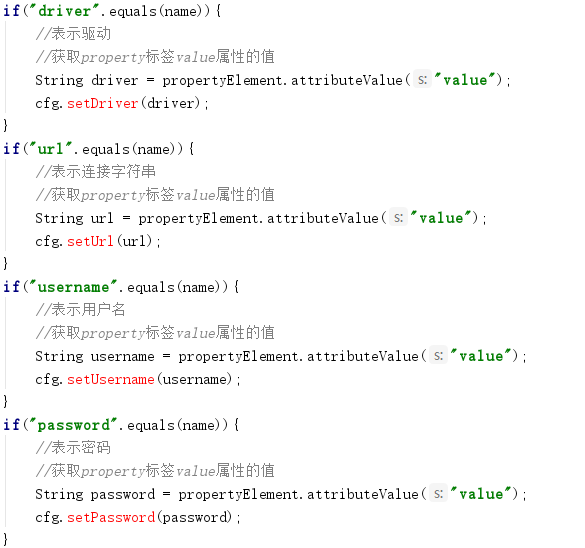
2、创建Configuration类
public class Configuration {
private String driver;
private String url;
private String username;
private String password;
private Map<String, Mapper> mappers = new HashMap<>();
public Map<String, Mapper> getMappers() {
return mappers;
}
public void setMappers(Map<String, Mapper> mappers) {
this.mappers.putAll(mappers);
}
public String getDriver() {
return driver;
}
public void setDriver(String driver) {
this.driver = driver;
}
public String getUrl() {
return url;
}
public void setUrl(String url) {
this.url = url;
}
public String getUsername() {
return username;
}
public void setUsername(String username) {
this.username = username;
}
public String getPassword() {
return password;
}
public void setPassword(String password) {
this.password = password;
}
}
此时解析xml的配置类还需要提供mapper类
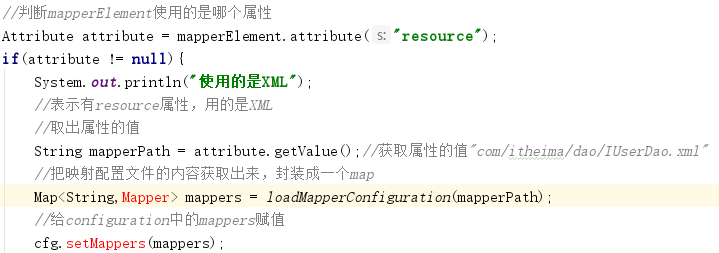

3、创建Mapper类

这时的Configuration类还缺少setMappers方法

添加方法
private Map<String, Mapper> mappers;
public Map<String, Mapper> getMappers() {
return mappers;
}
public void setMappers(Map<String, Mapper> mappers) {
this.mappers.putAll(mappers);
}
SqlSessionFactoryBuilder通过该解析类创建SqlSessionFactory对象
/**
* 用于常见一个sqlSessionFactory对象
*/
public class SqlSessionFactoryBuilder {
/**
* 根据参数的字节输入流来构建一个SQLSessionFactory工厂
* @param inputStream
* @return
*/
public SqlSessionFactory build(InputStream inputStream){
Configuration cfg = XMLConfigBuilder.loadConfiguration(inputStream);
return new DefaultSqlSessionFactory(cfg);
};
}
DefaultSqlSessionFactory是SqlSessionFactory的实现类
4、创建SqlSessionFactory实现类DefaultSqlSessionFactory
/**
* SqlSessionFactory接口的实现类
*/
public class DefaultSqlSessionFactory implements SqlSessionFactory{
private Configuration configuration;
public DefaultSqlSessionFactory(Configuration configuration) {
this.configuration = configuration;
}
/**用于获取一个新的操作数据库的对象
* 该方法需要提供数据库连接
* @return
*/
@Override
public SqlSession openSession() {
return new DefaultSession(configuration);
}
}
此时需要创建SqlSession的实现类
创建SqlSession实现类
public class DefaultSession implements SqlSession{
private Configuration configuration;
private Connection connection;
public DefaultSession(Configuration configuration) {
this.configuration = configuration;
connection = DataSourceUtils.getConnection(configuration);
}
/**
* 创建代理对象
* @param daoInterfaceClass dao的接口字节码
* @param <T>
* @return
*/
@Override
public <T> T getMapper(Class<T> daoInterfaceClass) {
//创建代理对象
return (T) Proxy.newProxyInstance(daoInterfaceClass.getClassLoader(), new Class[]{daoInterfaceClass}, new MapperProxy(configuration.getMappers(),connection));
}
/**
* 释放资源
*/
@Override
public void close() {
try {
if(connection!=null){
connection.close();
}
} catch (SQLException e) {
e.printStackTrace();
}
}
}
通过DataSourceUtils获取连接
public class DataSourceUtils {
public static Connection getConnection(Configuration configuration) {
try {
Class.forName(configuration.getDriver());
return DriverManager.getConnection(configuration.getUrl(),configuration.getUsername(),configuration.getPassword());
} catch (Exception e) {
throw new RuntimeException(e);
}
}
}
创建MapperProxy类该类实现的InvocationHandler,GetMapping方法的实现与Spring的AOP实现是原理是相似的
public class MapperProxy implements InvocationHandler{
private Map<String, Mapper> mappers;
private Connection connection;
public MapperProxy(Map<String, Mapper> mappers, Connection connection) {
this.mappers = mappers;
this.connection = connection;
}
@Override
public Object invoke(Object proxy, Method method, Object[] args) throws Throwable {
//1.获取方法名
String methodName = method.getName();
System.out.println(methodName);
//2.获取方法所在类的名称
String className = method.getDeclaringClass().getName();
System.out.println(className);
//3.组合key
String key = className+"."+methodName;
//4.获取mappers中的Mapper对象
Mapper mapper = mappers.get(key);
System.out.println(mapper);
if(mapper==null){
throw new IllegalArgumentException("传入参数有误");
}
//调用工具类查询所有
return new Executor().selectList(mapper,connection);
}
}
public class Executor {
public <E> List<E> selectList(Mapper mapper, Connection conn) {
PreparedStatement pstm = null;
ResultSet rs = null;
try {
//1.取出mapper中的数据
String queryString = mapper.getQueryString();//select * from user
String resultType = mapper.getResultType();
Class domainClass = Class.forName(resultType);
//2.获取PreparedStatement对象
pstm = conn.prepareStatement(queryString);
//3.执行SQL语句,获取结果集
rs = pstm.executeQuery();
//4.封装结果集
List<E> list = new ArrayList<E>();//定义返回值
while(rs.next()) {
//实例化要封装的实体类对象
E obj = (E)domainClass.newInstance();
//取出结果集的元信息:ResultSetMetaData
ResultSetMetaData rsmd = rs.getMetaData();
//取出总列数
int columnCount = rsmd.getColumnCount();
//遍历总列数
for (int i = 1; i <= columnCount; i++) {
//获取每列的名称,列名的序号是从1开始的
String columnName = rsmd.getColumnName(i);
//根据得到列名,获取每列的值
Object columnValue = rs.getObject(columnName);
//给obj赋值:使用Java内省机制(借助PropertyDescriptor实现属性的封装)
PropertyDescriptor pd = new PropertyDescriptor(columnName,domainClass);//要求:实体类的属性和数据库表的列名保持一种
//获取它的写入方法
Method writeMethod = pd.getWriteMethod();
//把获取的列的值,给对象赋值
writeMethod.invoke(obj,columnValue);
}
//把赋好值的对象加入到集合中
list.add(obj);
}
return list;
} catch (Exception e) {
throw new RuntimeException(e);
} finally {
release(pstm,rs);
}
}
private void release(PreparedStatement pstm,ResultSet rs){
if(rs != null){
try {
rs.close();
}catch(Exception e){
e.printStackTrace();
}
}
if(pstm != null){
try {
pstm.close();
}catch(Exception e){
e.printStackTrace();
}
}
}
}